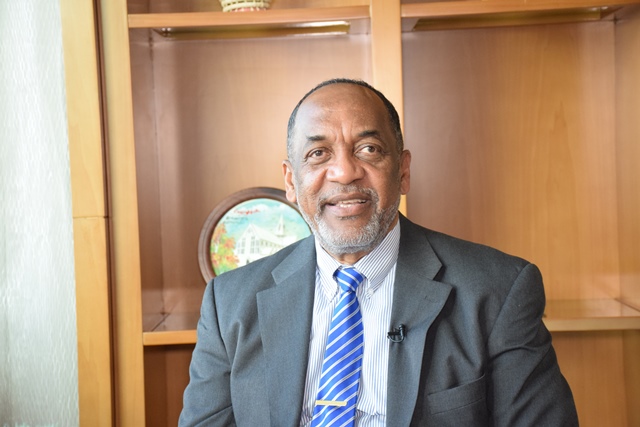Flaring offshore at ExxonMobil’s Liza-1 well has been reduced significantly from some 80 million cubic feet (cf) of natural gas per day to nearly 2 million cf but glitches in the reinjection process have continued and it rose to about 14 million cf per day as COVID-19 restrictions delayed staff from rectifying the issue, Head of the Environmental Protection Agency Dr Vincent Adams says.
“They went from about 80M [cf] per day down to almost about 2M cf per day but then they started running into problems again and they went back up a bit and are now about 14M to 15M cubic feet per day,” Adams told the Sunday Stabroek when contacted on Friday for an update.
“They are bringing in additional experts from the company that built the compressor because there are still some technical issues with the equipment. But as you know, the current COVID-19 restrictions require the 14-day mandatory quarantine before going out to the rig, so you have that,” he added.

For its part, the company confirms that it has begun the reinjection process and insists that the volumes flared are in line with not only industry standards but with this country’s laws.
“The design for our operations in Guyana does not utilize routine flaring. Start up for Liza Phase 1 involves temporary, non-routine flaring to fully commission the gas compression and injection systems for safe operations as outlined in the approved environmental impact assessment and permit,” the company said through its local Public and Government Affairs Advisor Janelle Persaud, in response to questions from this newspaper.
“The Liza Phase 1 project design eliminates routine flaring by using produced gas to power the Liza Destiny FPSO vessel and by reinjecting gas into the reservoir to conserve the gas and to improve oil recovery, thereby reducing emissions compared with traditional methods. We have successfully started up the gas handling system and begun gas injection into the reservoir. We continue to safely complete final commissioning of the system. This process is operationally necessary, standard in the industry and consistent with related Guyanese laws,” she added.
Adams explained that since he disclosed earlier this month that the company had flared 9 billion cf of natural gas since last December but was working to transition to injection, there had been positive developments.
He said that the transitioning process started and was going well “but again they got some technical issues with the compressor equipment”. His agency was briefed by Exxon and the company had to up their daily flaring quantum from a low of 2 million cf per day to about 14 million cf per day. “They have taken care of most of the problems and the rate is still significantly down but there are still some issues,” he said.
‘Pellucid’
The EPA Director stressed that while flaring is catered for at startup and in emergency circumstances, he has echoed prior warnings to the company that the glitches with the equipment leading to the large volume of flaring must “be a one-time occurrence”.
“It will not be acceptable in the future and they know that. They now know the design and all of that of the equipment so we have made this pellucid,” he said.
“You cannot avoid flaring at startup and that is a known. It was no one’s expectation that the flaring would be this long but this will not be allowed for future operations,” he added.
Following revelations that the company had flared some 9 billion cubic feet of natural gas as at earlier this month, a number of persons and a global environmental and human rights organization, the Center for International Environmental Law (CIEL), pointed to the effects of the greenhouse gas emissions on the environment.
CIEL called on the company to heed environmental pollution warnings and immediately stop the flaring, while adding that Guyanese should press for a pausing of works offshore and let ExxonMobil first answer “fundamental questions about its commitment to the environment in the country,” while assessing its capacity to monitor the works offshore.
“Flaring of 9 billion cubic feet of natural gas is more CO2 emissions than what the whole of Guyana would have used in three months – the entire country,” President of CIEL, Carroll Muffett, had told the Stabroek News via phone, from the United States .
“This speaks to the [lack of] seriousness with which this company is treating its obligations. You see, this is a company that has a record of flaring worldwide and Exxon’s explanation warrants some deeper enquiry. We are six months into production and you hear that a piece of equipment that should have been in place before testing malfunctioned? What if this was a leak? What is Guyana’s capacity to monitor what is happening? Fundamental questions need to be asked…,” he added.
Muffett, who has done extensive investigations into the work of Exxon and other companies worldwide, said that the volume of natural gas flared puts Guyana among the top ten gas-flaring countries in the world – even though first oil was produced from Guyana’s waters merely six months ago.
‘Nasty energy source’
The extraction of crude oil also results in raw natural gas associated with the oil being brought to the surface and flaring of the associated gas is commonly used to dispose of it in the absence of infrastructure to make use of it.
According to online oil and gas encyclopedia Petrowiki, “Associated gas is generally regarded as an undesirable byproduct, which is either reinjected, flared, or vented.”
Dr Maya Troz, a Guyanese Bio-Scientist and Professor at the University of South Florida, noted that “without a way to use what’s being produced, the rig will have to do something with natural gas. Given [that] it has a higher global warming potential than CO2, they flare to convert it to CO2 in the burning procedure as CH4 + 2O2 —> CO2 + 2H2O.”
She said that she believes that there are technologies to clean and compress natural gas at rig.
“Lie in bed with a nasty energy source, there is no way to sanitize any part of it,” she said, even as she posited that “during pumping, any natural gas leaks underwater could impact marine life.”
According to studies done by the McKinsey Global Institute research organization and Stanford University, technologies to decarbonize the extraction and production of hydrocarbons already exist and many are economically viable, yet the sector’s atmospheric emissions continue to rise.
“Our operations benchmarks show that raising operational performance has a large impact on emissions. And 90 percent of known technological solutions to decarbonization are within the grasp of operators at a cost of no more than $50/metric ton of carbon,” McKinsey states in an article on its website, “Toward a net-zero future: Decarbonizing upstream oil and gas operations.”
“There are multiple sustainable design options to make processes less emission-intensive. However, their use is not yet routine: traditional investment stage gates weight up-front capital costs over other considerations, such as energy efficiency or cost-to-operate. With total life-cycle value as the target function, operators may be more motivated to explore sustainable design. Doing so using proven technologies can not only reduce operating costs, but also generate new revenue streams,” the article also notes.
The World Bank encourages governments, oil companies, and development institutions around the world to endorse the “Zero Routine Flaring by 2030” Initiative and agree to cooperate to eliminate routine flaring no later than 2030. Many countries have also signed on to the World Bank’s Global Gas Flaring Reduction initiative but this newspaper could not find any document which states Guyana’s commitment.
It stated that its research shows that approximately 140 billion cubic meters of natural gas is burned annually, causing more than 300 million tons of CO2 to be emitted to the atmosphere.
CIEL’s President said that ExxonMobil’s operations here needs urgent monitoring since the fact that calculations show that the CO2 emissions from flaring over the six month period is more than what the country’s three month total is.
Unclear
It is unclear if any study is being done on the impact to the environment and climate change commitments from the flaring and if Muffett’s calculations are similar to that of the country’s Office for Climate Change (OCC), another oversight agency.
This newspaper has tried over the past two weeks to elicit answers from Head of the OCC, Janelle Christian. After several calls and emails, she last week Thursday replied saying, “Thank you for your email and questions, while I would like to discuss this matter with you for greater context, unfortunately my engagement with other pressing matters does not permit me to do so at this time, I trust that you would still be interested in doing so at a later date.”
It is also not clear how the current flaring will impact Guyana’s 2016 Paris Agreement and the commitment that this country will development a comprehensive Emissions Reduction Programme, as it positions itself to move more quickly and more closely towards full renewable energy use by 2025.
And while government has said that it will enter a new round of talks with Norway to support President David Granger’s Green State Development Strategy (GSDS) and particularly environmental safeguards that can realise a “green” economy, it is unclear how the current emissions will impact these negotiations.
The inclusion of natural gas as part of Guyana’s ‘Green State Plan’ had in 2017 seen a stalling of this country’s access to the US$80 million in payments for forest services from Norway.
Under that deal, signed in 2009, Norway agreed to pay up to US$250 million over five years for Guyana’s performance on limiting greenhouse gas emissions from deforestation and forest degradation, and for progress made against governance-related indicators.
It was only last December that Norway released the final payment of US$43.9 million, which this country had earned under the landmark forest protection pact between the two countries.
“The inclusion of natural gas in the energy mix is something which they have a problem with,” former Minister of State Joseph Harmon had previously told the Sunday Stabroek in an interview.
“We have said to them that natural gas is clean energy, even though it is not a renewable. It is clean energy and it is cheap energy and at this stage of our development, we have considered that to be very essential. Norway was saying that natural gas is not a renewable source of energy. We are having some discussions on if you include it, how much to include and so forth. So, this is where we are at this point in time with the Norwegians, with respect to our energy mix up to 2025,” he added.
Government has said that it wants to bring some of the natural gas to shore for domestic use.
Last week, Director of the Department of Energy Dr.Mark Bynoe informed that plans were “well advanced” and that plans are in the pipeline to engage the Private Sector.
ExxonMobil also confirmed that the offshore to coast natural gas project was still being discussed.
“We continue to have discussions with the Department of Energy on bringing gas to shore for domestic power,” Persaud said.






